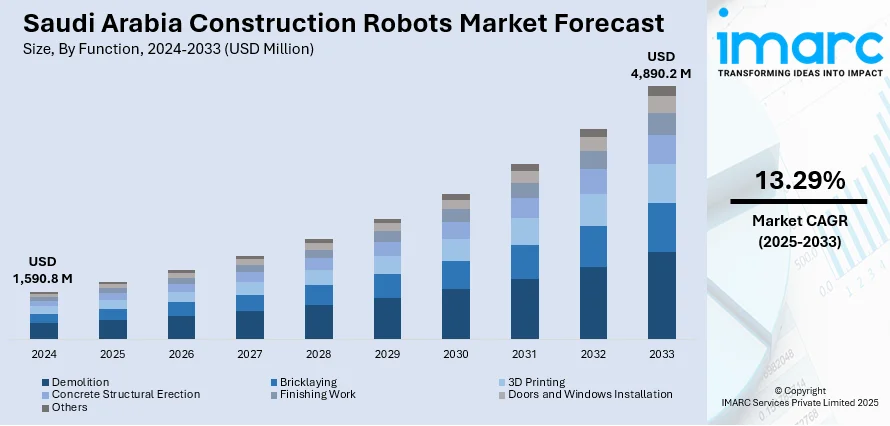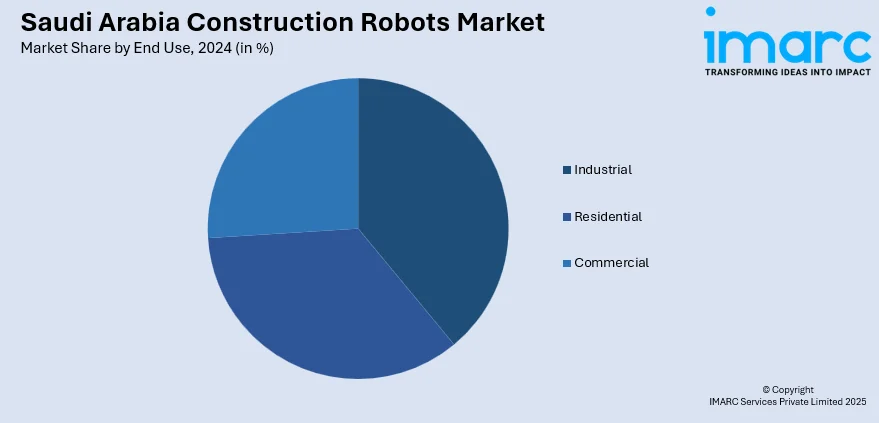
Saudi Arabia Construction Robots Market Size, Share, Trends and Forecast by Function, Type, End Use, and Region, 2025-2033
Saudi Arabia Construction Robots Market Overview:
The Saudi Arabia construction robots market size reached USD 1,590.8 Million in 2024. Looking forward, IMARC Group expects the market to reach USD 4,890.2 Million by 2033, exhibiting a growth rate (CAGR) of 13.29% during 2025-2033. The market is fueled by mega infrastructure projects in Vision 2030, growing labor shortages, and the emphasis on increased efficiency and safety. Advances in technology, including automation, 3D printing, and robotic material handling, are also fueling adoption, allowing for simplified complicated construction processes and lowering operating expenses.
|
Report Attribute
|
Key Statistics
|
|---|---|
|
Base Year
|
2024 |
|
Forecast Years
|
2025-2033
|
|
Historical Years
|
2019-2024
|
| Market Size in 2024 | USD 1,590.8 Million |
| Market Forecast in 2033 | USD 4,890.2 Million |
| Market Growth Rate 2025-2033 | 13.29% |
Saudi Arabia Construction Robots Market Trends:
Robotics Integration in Mega Projects
Saudi mega-projects, including NEOM and The Line, are leading the way in robotics integration into the construction sector. These projects focus on transforming urban development by integrating high-tech capabilities, such as robotics, into the process for greater efficiency and sustainability. For example, NEOM has entered into a partnership with GMT Robotics to automate the process of assembling rebar cages, minimizing human intervention and quality standards. This partnership not only expedites construction schedules but also promotes building a high-tech industrial economy in the area. Localizing production and establishing skilled employment opportunities, these projects support Saudi Vision 2030 goals, stimulating innovation and economic diversification. The successful application of robotics to these projects is paving the way for future projects, further fueling the Saudi Arabia construction robots market growth.

Automation Focus on Labor Efficiency
Construction in Saudi Arabia is becoming increasingly focused on using automation to minimize labor shortages and increase productivity. Robotic machines are being implemented to execute routine and manpower-based tasks like material handling and rebar assembly and thereby cut the reliance on human labor. This change alleviates safety concerns with labor shortages and enhances safety by reducing human exposure to risky tasks. Automation of construction tasks results in shorter project durations and less expense, so it is a good option for builders. In addition, the introduction of robotics aligns with the country's vision of enhancing its construction industry and enhancing technology. As automation becomes more prevalent, it is expected to drive further innovation and efficiency in the industry, contributing to the overall growth of the Saudi Arabia construction robots market share.
Development of Localized Robotics Manufacturing
In line with its Vision 2030 goals, Saudi Arabia is focusing on developing a localized robotics manufacturing sector to support its construction industry. Cooperation with local organizations and foreign robotics companies is enabling the country to set up manufacturing plants within the nation. The plants specialize in making construction robots and components, minimizing dependence on imports and stimulating homegrown innovation. Through investments in local manufacturing, Saudi Arabia seeks to develop a stable supply chain for construction robotics with ready availability and affordable options. In addition, the program supports the creation of jobs and the formation of a well-skilled robotic and automation technologies workforce. Expansion of the domestic robotics manufacturing industry is anticipated to be a central driver of long-term success and sustainability, providing favorable impact on the Saudi Arabia construction robots market outlook.
Saudi Arabia Construction Robots Market Segmentation:
IMARC Group provides an analysis of the key trends in each segment of the market, along with forecasts at the regional level for 2025-2033. Our report has categorized the market based on function, type, and end use.
Function Insights:
- Demolition
- Bricklaying
- 3D Printing
- Concrete Structural Erection
- Finishing Work
- Doors and Windows Installation
- Others
The report has provided a detailed breakup and analysis of the market based on the function. This includes demolition, bricklaying, 3D printing, concrete structural erection, finishing work, doors and windows installation, and others.
Type Insights:
- Traditional Robot
- Robotic Arm
- Exoskeleton
A detailed breakup and analysis of the market based on the type has also been provided in the report. This includes traditional robot, robotic arm, and exoskeleton.
End Use Insights:

- Industrial
- Residential
- Commercial
A detailed breakup and analysis of the market based on the end use has also been provided in the report. This includes industrial, residential, and commercial.
Regional Insights:
- Northern and Central Region
- Western Region
- Eastern Region
- Southern Region
The report has also provided a comprehensive analysis of all the major regional markets, which include Northern and Central Region, Western Region, Eastern Region, and Southern Region.
Competitive Landscape:
The market research report has also provided a comprehensive analysis of the competitive landscape. Competitive analysis such as market structure, key player positioning, top winning strategies, competitive dashboard, and company evaluation quadrant has been covered in the report. Also, detailed profiles of all major companies have been provided.
Saudi Arabia Construction Robots Market News:
- In March 2025, Saudi Arabia achieved a major milestone in building innovation by finalizing a contract between NEOM and Samsung C&T to carry out the world's largest automation of steel structure assembly. The funding, exceeding 1.300 billion Saudi riyals ($350 million), will decrease manual labor duration by up to 80% and lower costs by 40%. The collaboration seeks to establish factories in NEOM that utilize cutting-edge robots for producing and assembling structural reinforcements, generating more than 2,000 specialized jobs and strengthening Saudi Arabia's position in sustainable construction innovation.
Saudi Arabia Construction Robots Market Report Coverage:
| Report Features | Details |
|---|---|
| Base Year of the Analysis | 2024 |
| Historical Period | 2019-2024 |
| Forecast Period | 2025-2033 |
| Units | Million USD |
| Scope of the Report |
Exploration of Historical Trends and Market Outlook, Industry Catalysts and Challenges, Segment-Wise Historical and Future Market Assessment:
|
| Functions Covered | Demolition, Bricklaying, 3D Printing, Concrete Structural Erection, Finishing Work, Doors and Windows Installation, Others |
| Types Covered | Traditional Robot, Robotic Arm, Exoskeleton |
| End Uses Covered | Industrial, Residential, Commercial |
| Regions Covered | Northern and Central Region, Western Region, Eastern Region, Southern Region |
| Customization Scope | 10% Free Customization |
| Post-Sale Analyst Support | 10-12 Weeks |
| Delivery Format | PDF and Excel through Email (We can also provide the editable version of the report in PPT/Word format on special request) |
Key Questions Answered in This Report:
- How has the Saudi Arabia construction robots market performed so far and how will it perform in the coming years?
- What is the breakup of the Saudi Arabia construction robots market on the basis of function?
- What is the breakup of the Saudi Arabia construction robots market on the basis of type?
- What is the breakup of the Saudi Arabia construction robots market on the basis of end use?
- What is the breakup of the Saudi Arabia construction robots market on the basis of region?
- What are the various stages in the value chain of the Saudi Arabia construction robots market?
- What are the key driving factors and challenges in the Saudi Arabia construction robots market?
- What is the structure of the Saudi Arabia construction robots market and who are the key players?
- What is the degree of competition in the Saudi Arabia construction robots market?
Key Benefits for Stakeholders:
- IMARC’s industry report offers a comprehensive quantitative analysis of various market segments, historical and current market trends, market forecasts, and dynamics of the Saudi Arabia construction robots market from 2019-2033.
- The research report provides the latest information on the market drivers, challenges, and opportunities in the Saudi Arabia construction robots market.
- Porter's five forces analysis assist stakeholders in assessing the impact of new entrants, competitive rivalry, supplier power, buyer power, and the threat of substitution. It helps stakeholders to analyze the level of competition within the Saudi Arabia construction robots industry and its attractiveness.
- Competitive landscape allows stakeholders to understand their competitive environment and provides an insight into the current positions of key players in the market.
Need more help?
- Speak to our experienced analysts for insights on the current market scenarios.
- Include additional segments and countries to customize the report as per your requirement.
- Gain an unparalleled competitive advantage in your domain by understanding how to utilize the report and positively impacting your operations and revenue.
- For further assistance, please connect with our analysts.
 Request Customization
Request Customization
 Speak to an Analyst
Speak to an Analyst
 Request Brochure
Request Brochure
 Inquire Before Buying
Inquire Before Buying




.webp)




.webp)












